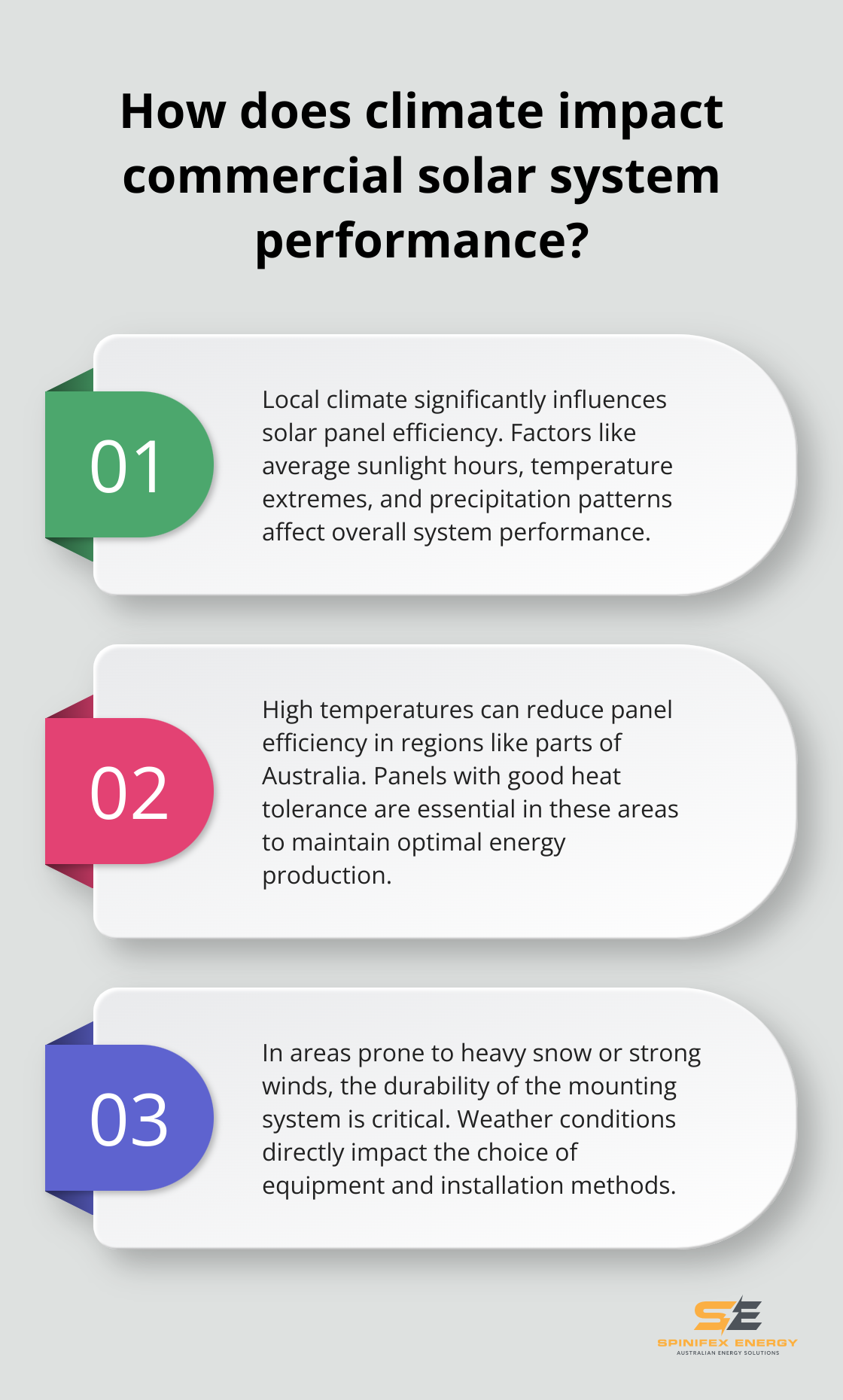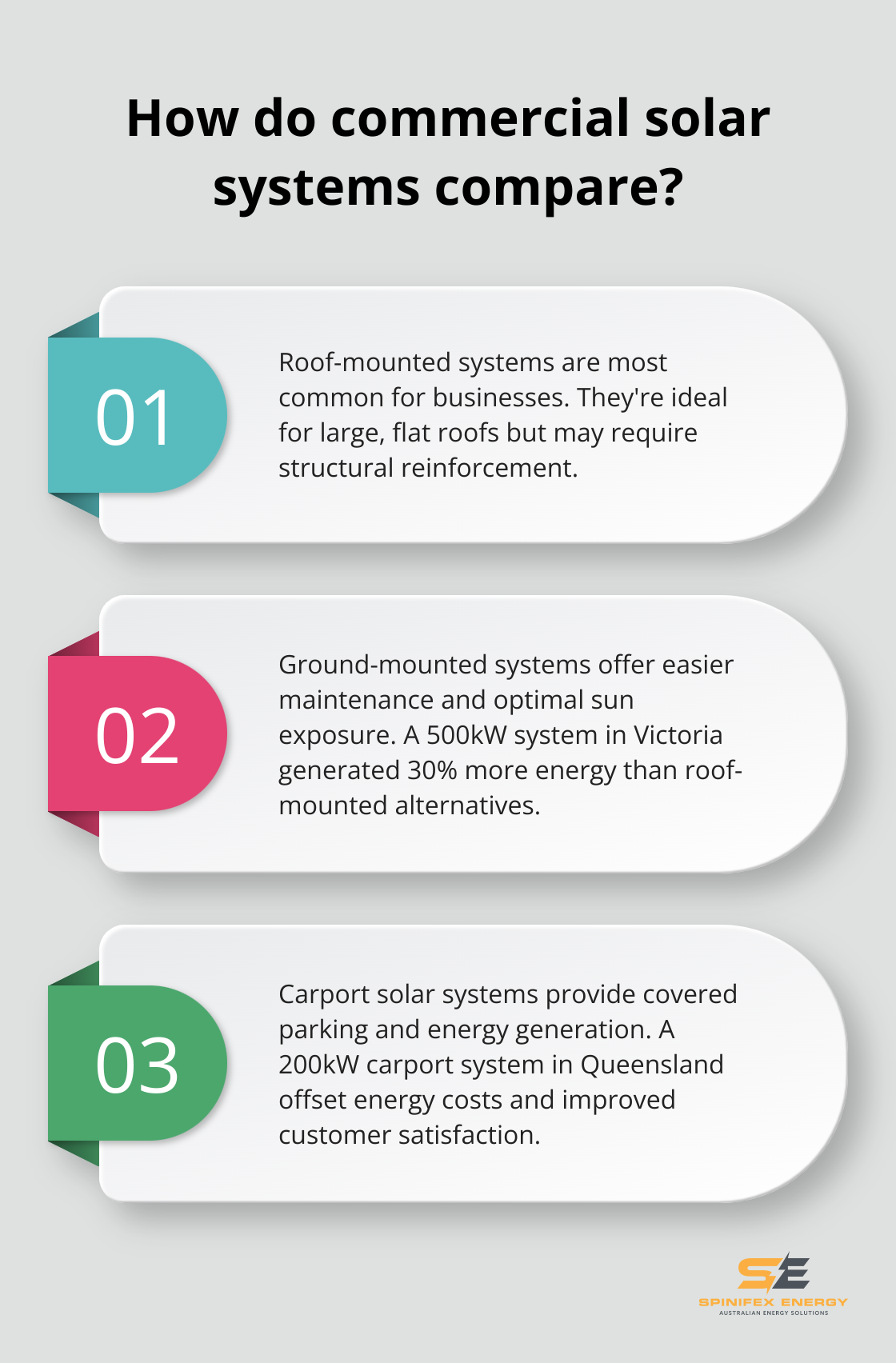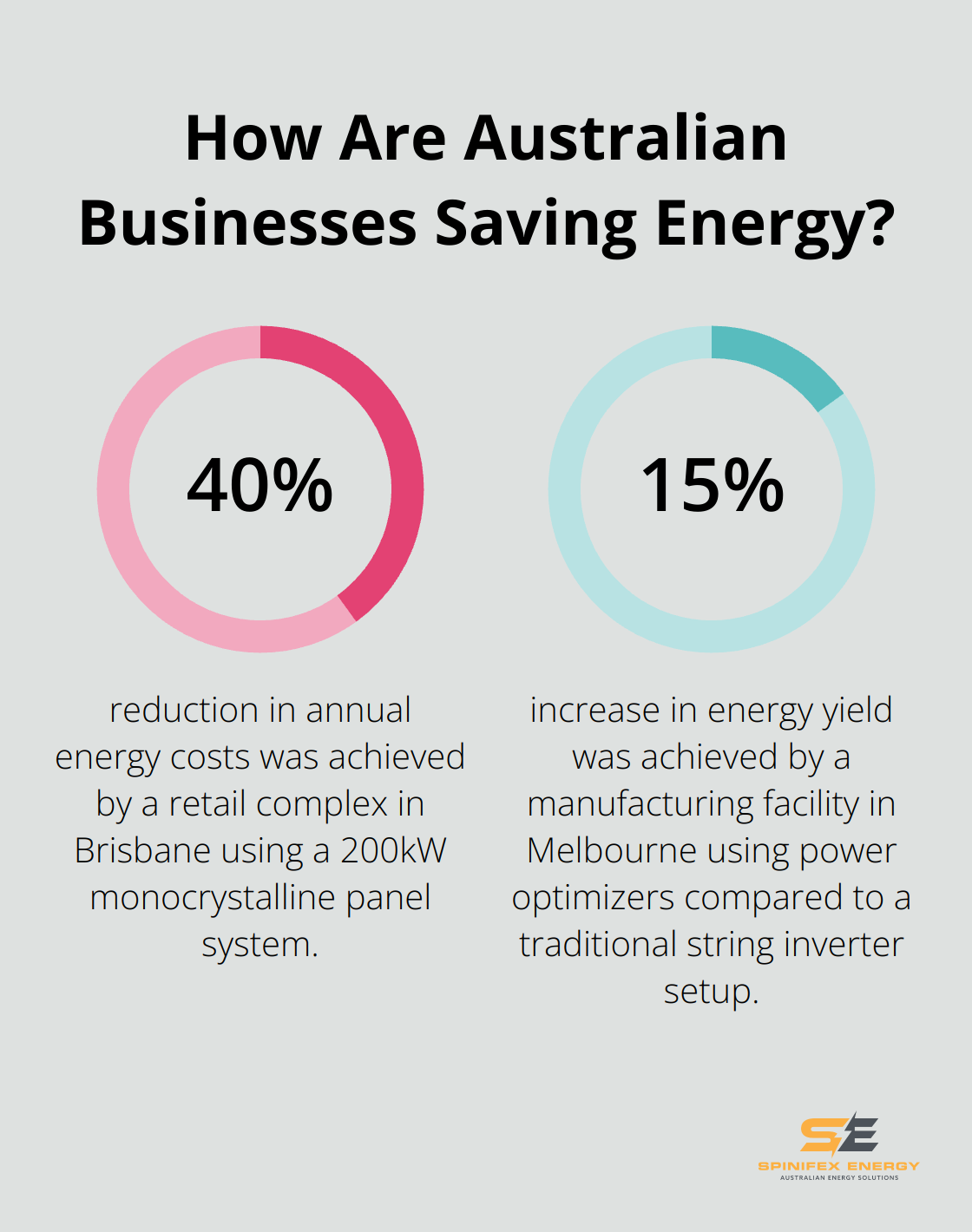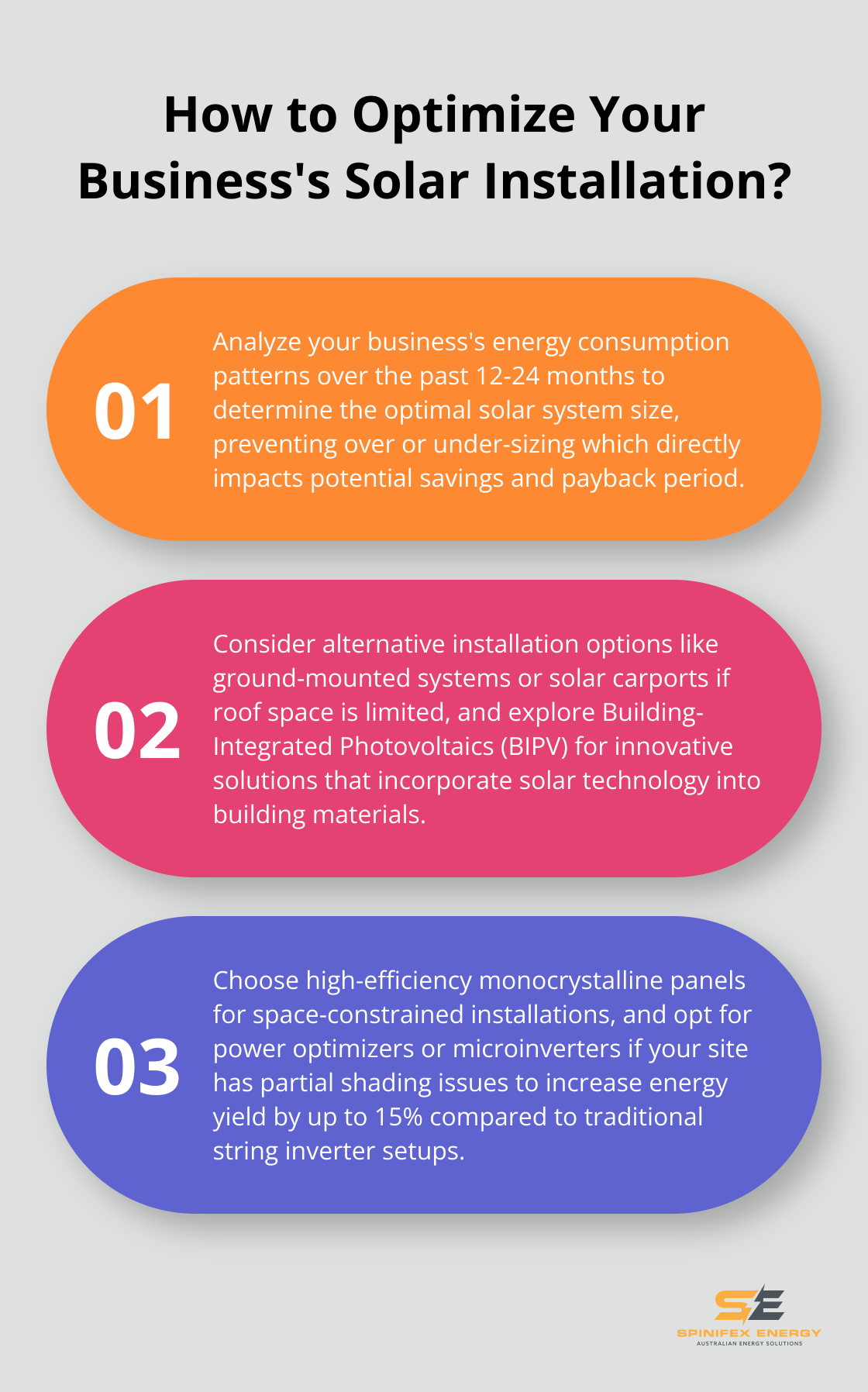Choosing the right commercial solar power system is a critical decision for businesses looking to reduce energy costs and boost sustainability. At Spinifex Energy, we’ve seen firsthand how the right system can transform a company’s energy profile.
This guide will walk you through the key factors to consider when selecting a commercial solar power system, from energy consumption to available space and budget constraints. We’ll also explore different types of systems and essential components to help you make an informed choice for your business.
What Factors Matter Most for Your Commercial Solar System?
Energy Consumption Patterns
The first step in choosing the right solar system is to analyze your business’s energy consumption patterns. This involves a review of your electricity bills from the past 12-24 months to identify peak usage times and seasonal variations. Advanced energy monitoring tools provide a detailed breakdown of your consumption, which helps determine the optimal system size for your needs.

A manufacturing facility operating 24/7 will have different energy requirements compared to a retail store open during standard business hours. Understanding your specific energy profile prevents over or under-sizing your solar system, which directly impacts your potential savings and payback period.
Space and Structural Considerations
The available space for solar panel installation plays a key role in system design. Roof-mounted systems are common, but they require a sturdy roof structure with minimal shading. If your roof is older or needs repairs, it’s wise to address these issues before installation.
For businesses with limited roof space, ground-mounted systems or solar carports might be viable alternatives. These options can also provide additional benefits, such as covered parking for employees or customers. Building-integrated photovoltaics (BIPV) offer another innovative solution, which seamlessly incorporates solar technology into building materials like windows or facades.
Climate and Weather Impact
Local climate conditions significantly influence solar system performance. While solar panels can generate electricity in various weather conditions, factors like average sunlight hours, temperature extremes, and precipitation patterns affect overall efficiency.
In regions with high temperatures (such as parts of Australia), it’s essential to choose solar panels with good heat tolerance to maintain efficiency. Conversely, in areas prone to heavy snow or strong winds, the mounting system’s durability becomes a critical factor.
Financial Considerations and Incentives
The upfront cost of a commercial solar system can be substantial, but it’s important to view it as a long-term investment. When assessing the financial aspects, consider:
- Initial installation costs
- Potential energy savings over the system’s lifespan
- Available government incentives and rebates
- Financing options (e.g., power purchase agreements, leases, or outright purchase)
Many businesses find that solar systems pay for themselves within 3-7 years, depending on factors like system size, energy costs, and available incentives.
Additionally, staying up-to-date with the latest government incentives can help you navigate complex rebate programs to maximize your savings. For instance, the Small-scale Renewable Energy Scheme (SRES) in Australia offers significant benefits for businesses installing solar systems up to 100kW.
These factors form the foundation for selecting the right commercial solar power system. The next step involves exploring the various types of systems available to match your specific requirements.
Which Commercial Solar System Fits Your Business?
At Spinifex Energy, we’ve observed various commercial solar systems in action. Each type has its strengths, and the best choice depends on your specific business needs. Let’s explore the main options to help you make an informed decision.
Roof-Mounted Systems: The Classic Choice
Roof-mounted systems are the most common type of commercial solar installation. They’re ideal for businesses with large, flat roofs and minimal shading. These systems don’t require additional land, making them perfect for urban areas where space is at a premium.

However, roof condition is critical. Some businesses need to reinforce their roofs to support the added weight of solar panels. It’s essential to have a structural engineer assess your roof before installation.
Ground-Mounted Systems: Maximizing Energy Production
For businesses with ample land, ground-mounted systems offer several advantages. They’re easier to access for maintenance and can be positioned for optimal sun exposure. These systems work well for agricultural businesses and large industrial complexes.
A manufacturing plant in rural Victoria opted for a 500kW ground-mounted system. This choice allowed them to generate 30% more energy than a roof-mounted alternative due to better positioning and cooling.
Carport Solar Systems: Dual-Purpose Solutions
Carport solar systems are gaining popularity, especially among retail businesses and office complexes. They provide covered parking while generating clean energy. A shopping center in Queensland installed a 200kW carport system, which not only offset their energy costs but also increased customer satisfaction by providing shaded parking.
Building-Integrated Photovoltaics (BIPV): The Future of Solar
BIPV systems integrate solar technology directly into building materials. While still a developing technology, it shows promise for new constructions and major renovations. Successful BIPV installations exist in high-end office buildings, where solar cells are incorporated into windows and facades.
One innovative project in Sydney used BIPV solar tiles to replace traditional roofing materials, generating 80kW of power while maintaining the building’s aesthetic appeal.
When choosing between these options, consider your available space, energy needs, and budget. A thorough site assessment will help recommend the most suitable system for each business. The right choice can lead to significant long-term savings and sustainability benefits.
Now that we’ve explored the types of commercial solar systems, let’s examine the key components and technologies that make these systems work efficiently.
What Makes a Commercial Solar System Tick?
The Power of Solar Panels
Solar panels form the foundation of any commercial solar power system. Two main types exist: monocrystalline and polycrystalline. Monocrystalline panels offer higher efficiency and a sleek black appearance, making them ideal for space-constrained installations. Polycrystalline panels provide a more cost-effective solution for larger installations where space isn’t a limiting factor.

A recent project for a retail complex in Brisbane used a 200kW system with high-efficiency monocrystalline panels. This choice maximized energy production within their limited roof space, resulting in a 40% reduction in annual energy costs.
Inverters: The Brains of the Operation
Inverters convert the DC power generated by solar panels into AC power for business use or grid feed-in. Three main types exist:
- String inverters: The most common and cost-effective option for large, uniform installations.
- Microinverters: More expensive but offer better performance for systems with partial shading or complex roof structures.
- Power optimizers: Combine the benefits of both, providing panel-level optimization with a central inverter.
A manufacturing facility in Melbourne with partial shading issues used a system with power optimizers. This solution increased their energy yield by 15% compared to a traditional string inverter setup.
Mounting Systems: Securing Your Investment
The mounting system plays a vital role in the longevity and performance of your solar installation. For roof-mounted systems, factors like wind load, roof type, and local building codes influence the selection of the right mounting solution.
In cyclone-prone areas of Northern Australia, specially designed cyclone-rated mounting systems protect solar installations. These robust solutions withstand wind speeds of up to 300 km/h, providing peace of mind for business owners.
Monitoring and Control Systems: Keeping You Informed
Modern commercial solar systems include sophisticated monitoring and control systems. These tools provide real-time data on energy production, system performance, and potential issues.
A logistics company in Perth uses a cloud-based monitoring system that alerts them to any performance drops. This proactive approach helps them maintain optimal system efficiency, maximizing their return on investment.
When selecting components for your commercial solar system, consider not just the upfront costs but also the long-term performance and reliability. Try to design systems that balance efficiency, durability, and cost-effectiveness (ensuring a solar solution that delivers value for years to come).
Final Thoughts
Selecting the right commercial solar power system requires careful evaluation of energy needs, space constraints, local climate, and financial factors. The variety of available systems (roof-mounted, ground-mounted, carports, or building-integrated photovoltaics) offers flexibility for businesses of all sizes. High-quality components, including efficient solar panels, inverters, mounting systems, and monitoring tools, contribute to optimal performance and longevity.

Professional consultation provides invaluable insights for businesses considering solar power. Spinifex Energy specializes in tailoring solar solutions to meet unique business needs, maximizing savings and promoting sustainability. Our expert assessment can uncover nuances specific to your business and location.
Commercial solar power systems offer substantial long-term benefits beyond immediate electricity cost reductions. These include increased energy independence, improved sustainability credentials, and protection against future energy price volatility. With potential savings of up to 100% on electricity costs (and the opportunity to contribute to a cleaner environment), solar power represents a smart choice for forward-thinking businesses.

